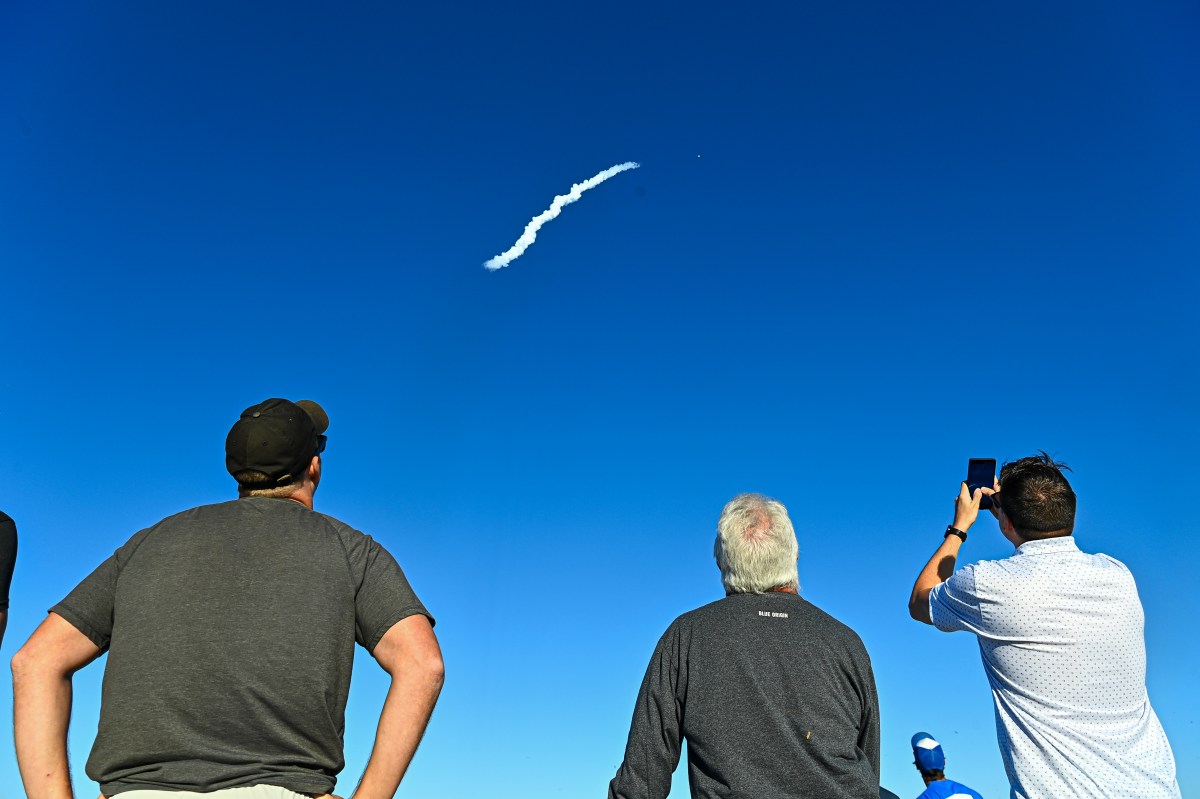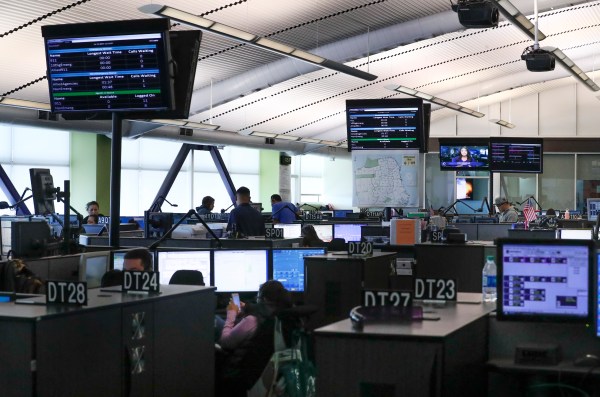Turn any article into a podcast. Upgrade now to start listening.
Premium Members can share articles with friends & family to bypass the paywall.
You’re reading The Morning Dispatch, our flagship daily newsletter explaining all the news you need to know today in fewer than 10 minutes. To unlock the full version, become a Dispatch member today.
Happy Tuesday! The Louvre Museum has temporarily closed some of its offices and a gallery due to concerns about the building’s structural fragility. Let's hope its builders did a better job than its security team.
Quick Hits: Today’s Top Stories
- A federal judge ruled on Monday that Justice Department lawyers must provide former FBI Director James Comey’s legal defense team with the complete records of the grand jury proceedings that led to his indictment, citing a “disturbing pattern of profound investigative missteps.” Federal Magistrate Judge William Fitzpatrick wrote that the two-count indictment secured by Lindsey Halligan—the interim district attorney for the Eastern District of Virginia and a former White House aide—“may rise to the level of government misconduct resulting in prejudice to Mr. Comey” and a dismissal of the case against him, due to nearly a dozen irregularities he listed in his opinion. These included Halligan’s statements to members of the grand jury, assuring them that prosecutors would present further incriminating evidence at trial, beyond what they had already presented, and where Halligan seemingly ignored that jurors are not permitted to draw adverse inferences from a person’s refusal to testify.
- Polish Prime Minister Donald Tusk said yesterday that an explosion on a railway line on Sunday was “an unprecedented act of sabotage” likely carried out on the orders of “foreign services.” While he did not name Russia, the explosion damaged tracks on a line used to carry supplies from Poland to Ukraine. Tusk vowed to punish the perpetrators, no matter who their “backers” were. In Romania, authorities ordered a village that lies on the river bordering Ukraine evacuated after a drone reportedly struck a cargo ship on the Ukrainian side of the river. In Paris, Ukrainian President Volodymyr Zelensky signed a letter of intent to purchase up to 100 Rafale fighter jets from France, along with drones and air defence systems. He visited the country to discuss the formation of a multinational European force intended to enforce a ceasefire in Ukraine, in the event of an agreement being signed with Russia. Last night, Russian forces launched a drone attack on Ukraine’s fourth-largest city, Dnipro, and fired missiles on the Kharkiv region, killing at least nine people, including a 17-year-old girl.
- The U.N. Security Council on Monday voted to adopt the U.S.-proposed peace plan for Gaza, with Russia and China abstaining. The plan, which calls for the creation of a multinational stabilization force for Gaza, the resumption of aid to the territory, and the establishment of a transitional technocratic government for Gaza, overseen by an as-yet-unnamed “Board of Peace.” Multiple Arab and Muslim countries, including Saudi Arabia, Egypt, the United Arab Emirates, Jordan, Qatar, Turkey, and Pakistan, backed the deal. The vote gives President Donald Trump’s 20-point peace plan the weight of international law, although many steps remain to be implemented. On Monday, Germany said that it would resume arms exports to Israel that it paused in August, due to the ceasefire between Israel and Hamas having “stabilized.” Also, Prime Minister Benjamin Netanyahu yesterday condemned the growing settler violence in the West Bank, which has increased over the past weeks. On Sunday, settlers fought with Israeli police and attacked a Palestinian village, burning three cars and houses.
- Former Bangladeshi Prime Minister Sheikh Hasina, who was ousted from office last year after student protests and now resides in India, was sentenced to death Monday along with one of her aides, former Home Minister Asaduzzaman Khan. The International Crimes Tribunal based in Dhaka, the capital, convicted Hasina on five charges of crimes against humanity for ordering the use of lethal force against protestors in July and August 2024. Up to 1,400 students, who were protesting against what they viewed as government corruption, were killed by security forces. In response to the verdict, Hasina said that her decisions were made with the intent to minimize loss of life.
- The House of Representatives intends to vote today on a resolution that would force the release of files related to the investigation of convicted sex offender Jeffrey Epstein, a move that would then send the resolution to a Senate vote and, potentially, the president’s desk. President Donald Trump had lobbied against scheduling such a vote, only to reverse his position Sunday. Senate Majority Leader John Thune, a Republican, has yet to say whether he will bring the measure to a vote on the Senate floor this week.
Man on the Moon

It’s been more than 50 years since an astronaut stepped onto the moon, but many eyes are turned upward, hoping for a return—and not just at NASA. In just 20 years, China’s space program has gone from lobbing a few probes into space to running a competitive lunar mission. It plans to land its own astronauts on the moon by 2030 and has already completed successful unmanned missions to the far side of the moon—regions that NASA space programs have yet to reach. On Friday, three Chinese astronauts returned to Earth—after 204 days in orbit—in a landing that was delayed more than a week when suspected space debris struck their Shenzhou-20 spacecraft, causing a cracked window.
Every day, China continues to be very public about its space program, and private rocket companies make news about their launches seemingly every week. Last Thursday, Jeff Bezos’ Blue Origin launched its New Glenn booster rocket for the second time. SpaceX continues to develop the Starship rocket, conducting five launches this year.
On the U.S. government side, NASA is awaiting the confirmation of a new administrator, Jared Isaacman, but is otherwise relatively quiet. America’s biggest space cheerleader, Elon Musk, is out of the Trump administration, has said the acting NASA administrator, Sean Duffy, had a “2 digit IQ” and was “trying to kill NASA,” and stated that moon missions are a distraction from going to Mars. Although the Artemis III manned moon mission is scheduled to launch in mid-2027, Politico reported last week—citing SpaceX internal documents the outlet obtained—that the company delayed the launch until September 2028, at the earliest.
The 21st century’s first space race is between the two largest geopolitical rivals—the United States and China. And it’s uncertain whether the experienced American space travelers will be able to beat Beijing.
You are receiving the free, truncated version of The Morning Dispatch. To read the full newsletter—and unlock all of our stories, podcasts, and community benefits—join The Dispatch as a paying member.
While NASA is a large, sprawling organization, with various objectives and programs, China’s National Space Administration (CNSA) —a civil-military agency of the Chinese government—has been narrowly focused on the moon. It successfully launched the uncrewed Chang’e 1, the country’s first lunar orbiter, in 2007, and six years later, the Chang’e 3 program successfully deployed the first Chinese moon rover. In 2019, Chang’e 4 Yutu rover became the first craft to land on the far side of the moon, in the moon’s southern hemisphere. Then, in 2024, Chang’e 6 ventured to the moon’s far-side region and returned with about two kilograms of rock samples from the area.
Beyond the bragging rights, particularly to Pink Floyd fans, getting to the far side of the moon could unlock access to frozen water, which research has long suggested may exist around the moon’s north and south poles.
China plans to launch Chang’e 7 in 2026 to explore the Shackleton crater in the south pole, a gaping pit about 13 miles across and 2.6 miles deep. The crater’s depth creates several permanently shadowed regions: a classification for areas that sunlight hasn’t touched for eons. As Kevin Wilcox—a senior technical writer for NASA—noted in August 2023, the floor temperature of these craters “could drop below -330°F,” conditions cold enough to freeze liquid nitrogen.
“If you can convert that into oxygen, and convert it into things like rocket fuel, then you can really start to think more seriously about establishing a human presence on the moon, ” Iain Boyd, an aerospace engineering professor at the University of Colorado Boulder, told TMD. Aside from maws like Shackleton, the moon’s south pole also sees proportionally more sunlight than other lunar surfaces: perfect for solar panels.
“I think these things are all technologically doable,” Boyd explained. “You’ve got the ice, you’ve got the water, you’ve got the oxygen, you’ve got the power.”
Todd Harrison, a senior fellow at the American Enterprise Institute who specializes in space policy, agreed, telling TMD, “It’s no coincidence that [China has] been sending missions to that area of the moon. ... I think the value of finding and mining that water and converting it into propellant is probably going to be one of the first utilizations of space resources that we see on the moon that becomes economically viable.”
More research is needed to verify the presence of ice water, but China is moving faster toward reaching it than anyone else.
“They’ve achieved a tremendous amount of progress in a relatively short space of time,” Boyd said. “China sees its space program as a public ‘illustration of their technological advances.’” The Chinese Communist Party aims for a “projection of soft power,” and it wants the average “person on the street to hear about China doing science on the moon.”
In the 1960s, NASA was both a demonstration of American power and innovation, but as the decades continued, the appetite for space exploration waned, with incidents like the fatal and avoidable Challenger disaster highlighting a less-favorable image of the U.S. space program. But as the Chinese space program mirrors its country—government-dominated, image-first, aggressively ambitious—America’s space program has turned to its country’s strengths, with private-sector competition around rocketry, and NASA researchers working away quietly on research that could become vitally important.
The current Chinese efforts wouldn’t be possible without NASA’s Lunar Prospector, launched in 1998, which orbited the moon to map its surface and found evidence indicating ice water in areas near the poles. It measured levels of hydrogen that could indicate 6 billion metric tons of frozen water on the surface of the two poles. And in NASA’s fiscal year 2025 budget, the agency requested $341 million for “technology maturation,” including for in-situ resource utilization (ISRU). That includes technology to convert ice water into fuel, as well as other innovations necessary to sustain a prospective moon settlement, such as the potential use of moondust to construct buildings or other material structures.
“For decades, NASA has been pursuing research and funding research across the U.S. on these kinds of very, very specific technologies,” Harrison said. This research doesn’t reveal some secret plan to build an American moon base; any dreams of doing so are spoiled by the extraordinary costs involved with shuttling heavy tools and machinery to the moon via weight-constrained rockets. As Boyd explained, if a nation were to ever build a lunar base for a consistent human presence, it would involve what he called a “layered approach,” where robots would build structures, create water from the ice and oxygen from the water, and then people would follow.
Instead, this research is essentially to ensure that the U.S. is not lagging behind China. “We don’t want to be surprised in five years’ time that suddenly China has landed people on the moon and is taking all that territory for themselves,” he said.
Though delayed, America’s most immediate and ambitious space exploration plan remains NASA’s Artemis III mission. If it launches in 2028, it will try to bring American astronauts back to the moon’s surface—and, for the first time, to the south pole—via the most powerful rocket in history, SpaceX’s Starship. By figuring out how to reuse and refuel components, Boyd said, “SpaceX revolutionized the cost of launching stuff into space.”
Starship isn’t quite ready for prime time yet, though. In the first three of Starship’s five total test launches this year, the spacecraft component temporarily lost communications or control during its return, leading twice to mid-air explosions. While test launches in August and October proved more successful, problems remain, such as how to fuel the world’s largest rocket ship. SpaceX’s solution is to use multiple Starships, assigning one to refuel the other while in Earth’s orbit. However, no rocket ship has successfully refueled another while in outer space. SpaceX is currently designing a newer Starship model, the V3, that SpaceX spokesman Dan Huot said in October features a “complete overhaul” of the spacecraft component to equip it for zero-gravity refueling. SpaceX currently plans a test launch of the Starship V3 to demonstrate mid-orbit refueling sometime in 2026, though the company noted that preliminary test launches of the newer model are needed before attempting the first-of-its-kind maneuver.
The race to the moon is on. And just because Americans landed first, in 1969, that doesn’t mean they can repeat it in the 21st century.
Today’s Must-Read
Why do large companies sometimes lobby for regulation in their own industries? When major crypto exchanges advocate for licensing or tech companies urge regulation of artificial intelligence, the explanation may be simpler than it appears: These companies understand how regulatory costs affect market structure. Mark Dalton, R Street’s senior director of technology and innovation, argues that pro-business policies are always pro-market policies. From Europe's GDPR to Dodd-Frank financial reforms, he tracks how compliance costs function like a hidden tax that large corporations can absorb while smaller competitors buckle under the burden—transforming consumer protection into competitor elimination.
Toeing the Company Line
Losing My Religion
Why Marjorie Taylor Greene’s Trump rebellion matters.
Rule by Rolex
On bribery, tariffs, and insolvency.
An Act of Contrition
Three suggestions for the penitent Marjorie Taylor Greene.
Did Congress Stretch the Commerce Clause Too Far? | Interview: Jonathan Karl
Reevaluating the constitutionality of statutory provisions.
Will AI Destroy Humanity? | Interview: Andy Mills
Are you a Doomer, Scout, or Accelerationist?
In Other News
Today in America:
- David Richardson, the acting chief of the Federal Emergency Management Agency (FEMA), left his position yesterday after just six months.
- The Trump administration filed a lawsuit against California over new state laws that bar federal agents from wearing masks, and require that they have identification while conducting operations.
- Defense Secretary Pete Hegseth has assigned Deputy Defense Secretary Steve Feinberg to oversee the long-running case of the 2000 bombing of the U.S.S. Cole, which killed 17 American sailors. The trial of the orchestrator of the bombing is scheduled to start June 1 next year.
- Analysis from the Century Foundation think tank found that more Americans are behind on paying their utility bills, up 9.7 percent annually from April-June last year.
- Dolly Parton, Debbie Allen, and Tom Cruise were awarded honorary Oscars at Sunday night’s Governors Awards.
Around the World:
- A makeshift bridge collapsed at a cobalt mine in the Democratic Republic of Congo, killing at least 32 miners.
- A bus of Indian pilgrims travelling through Saudi Arabia crashed into an oil tanker yesterday, killing 45 on board. Only one person survived.
- Portuguese officials arrested Brazilian drug lord Ygor Daniel Zago, who is one of the leaders of Brazil’s largest criminal enterprise, Primeiro Comando da Capital (PCC).
On the Money:
- The hedge fund Thiel Macro, run by billionaire Peter Thiel, sold its entire $100 million Nvidia stake, and reduced its stake in Tesla.
- Jeff Bezos has co-founded a new artificial intelligence startup, Project Prometheus, focused on engineering and manufacturing for computers, cars, and rockets.
- A Senate committee led by Ted Cruz announced yesterday it will investigate Major League Baseball following its recent gambling scandal.
- Ford became the second partner with Amazon to sell used cars on the e-commerce platform, following Hyundai, which started doing so last year.
Worth Your Time:
- “Kash Patel’s Acts of Service” (New Yorker)
- Emily Bazelon and Rachel Poser speak to 60 attorneys to understand the state of the Justice Department. (New York Times)
- Ana Lucia Araujo writes about the history of slavery in Latin America. (Aeon)
- Jason Schreier reports on the seven-year development of the indie-hit video game Dispatch (Bloomberg)
Presented Without Comment
CNN: TSA Investigating How a Meat Cleaver Made It Onto a Plane in Portland
Also Presented Without Comment
Dexetro: Man Who Cryogenically Froze His Wife Faces Backlash After Finding New Love Years Later
Also Also Presented Without Comment
Scientific American: Raccoons Are Showing Early Signs of Domestication
Let Us Know
Have any thoughts or questions about today’s newsletter? Drop us a note in the comments or by emailing us at tmd.questions@thedispatch.com. We read every submission, and your message could be featured in an upcoming “Behind the Scenes” segment.
Have any thoughts or questions about today’s newsletter? Become a member to unlock commenting privileges and access to a members-only email address. We read every submission, and answer questions in the following edition of TMD.
Correction, November 18, 2025: This newsletter has been amended to reflect that Thursday's flight was the second for Blue Origin's New Glenn rocket.

















Please note that we at The Dispatch hold ourselves, our work, and our commenters to a higher standard than other places on the internet. We welcome comments that foster genuine debate or discussion—including comments critical of us or our work—but responses that include ad hominem attacks on fellow Dispatch members or are intended to stoke fear and anger may be moderated.
With your membership, you only have the ability to comment on The Morning Dispatch articles. Consider upgrading to join the conversation everywhere.